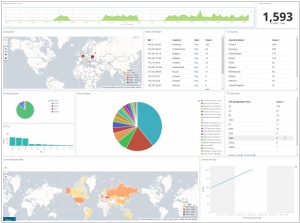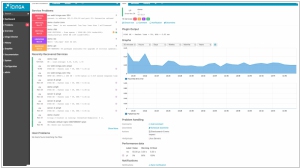ELK vs Icinga
July 23, 2023 | Author: Michael Stromann
13

ELK is the acronym for three open source projects: Elasticsearch, Logstash, and Kibana. Elasticsearch is a search and analytics engine. Logstash is a server‑side data processing pipeline that ingests data from multiple sources simultaneously, transforms it, and then sends it to a "stash" like Elasticsearch. Kibana lets users visualize data with charts and graphs in Elasticsearch.
See also:
Top 10 IT Monitoring software
Top 10 IT Monitoring software
ELK (Elasticsearch, Logstash, Kibana) and Icinga are two distinct tools used for different purposes in the realm of IT infrastructure monitoring and management. ELK is primarily a log management and analytics stack that allows organizations to collect, process, store, and visualize log data. It excels in providing real-time insights into the health and performance of applications and systems through the use of Elasticsearch for indexing and searching, Logstash for log ingestion and parsing, and Kibana for interactive data visualization. On the other hand, Icinga is an open-source monitoring platform designed to monitor the availability and performance of various components in an IT infrastructure, such as servers, services, network devices, and applications. It provides robust monitoring capabilities with support for alerting, historical data tracking, and reporting, making it valuable for ensuring the uptime and reliability of critical systems.
The key difference between ELK and Icinga lies in their core functions and areas of focus. ELK is primarily tailored for log analysis and visualization, providing insights into the behavior and events of systems and applications. It is especially useful for identifying issues and troubleshooting incidents through log data analysis. On the other hand, Icinga focuses on active monitoring and alerting, actively checking the health and status of monitored components and notifying administrators of any deviations or problems. It is more geared towards proactive monitoring and maintaining the overall stability of the IT infrastructure.
Moreover, ELK and Icinga differ in their approaches to data collection and monitoring sources. ELK is more suited for handling log data generated by various applications, services, and systems. It can aggregate logs from different sources and provide a unified view for analysis. In contrast, Icinga primarily relies on active checks through its agents and plugins, which periodically collect data from the monitored components and report back to the central monitoring server. This allows Icinga to provide real-time monitoring and immediate alerts when predefined thresholds are exceeded. Overall, while ELK and Icinga serve different purposes, they can complement each other in a comprehensive monitoring and troubleshooting toolkit, with ELK providing in-depth log analysis and Icinga delivering active infrastructure monitoring and alerting capabilities.
See also: Top 10 IT Monitoring software
The key difference between ELK and Icinga lies in their core functions and areas of focus. ELK is primarily tailored for log analysis and visualization, providing insights into the behavior and events of systems and applications. It is especially useful for identifying issues and troubleshooting incidents through log data analysis. On the other hand, Icinga focuses on active monitoring and alerting, actively checking the health and status of monitored components and notifying administrators of any deviations or problems. It is more geared towards proactive monitoring and maintaining the overall stability of the IT infrastructure.
Moreover, ELK and Icinga differ in their approaches to data collection and monitoring sources. ELK is more suited for handling log data generated by various applications, services, and systems. It can aggregate logs from different sources and provide a unified view for analysis. In contrast, Icinga primarily relies on active checks through its agents and plugins, which periodically collect data from the monitored components and report back to the central monitoring server. This allows Icinga to provide real-time monitoring and immediate alerts when predefined thresholds are exceeded. Overall, while ELK and Icinga serve different purposes, they can complement each other in a comprehensive monitoring and troubleshooting toolkit, with ELK providing in-depth log analysis and Icinga delivering active infrastructure monitoring and alerting capabilities.
See also: Top 10 IT Monitoring software




